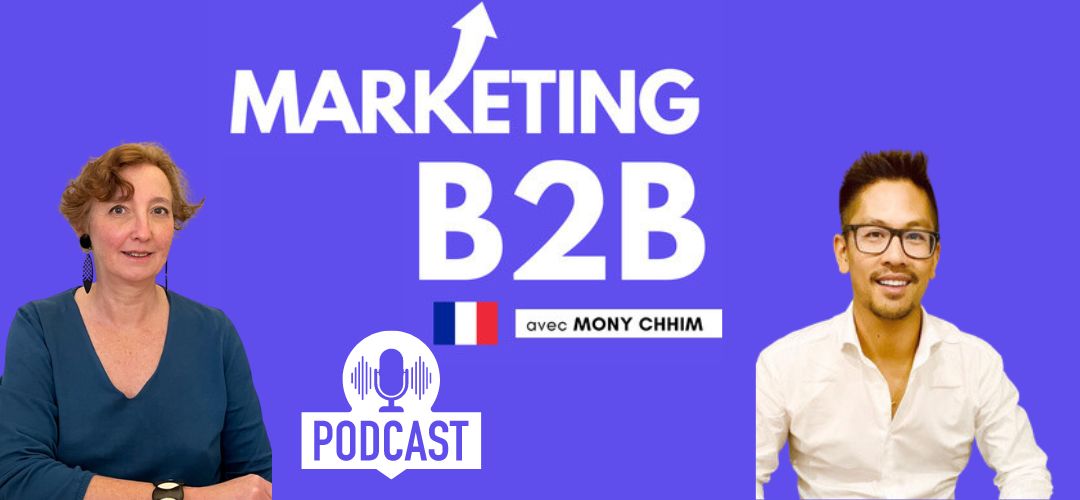This month, I participated to Mony Chhim’s Marketing BtB podcast. Interviewed by this talented marketer, I provided some of my best marketing tips on co-marketing ops and the numerous benefits they can bring.
Link to the podcast in french
Here is a translation of the essential parts of the podcast:
Mony : We discussed about the 7Ps on our last call, can you tell us more about it?
Nathalie: Sure, at the beginning of my career, marketing was more about customers and how to make them consume more while maximizing profit. We worked on the elements of the mix, the 4 Ps (product price promotion place) with only the target customer in mind.
Today, corporate social responsibility (CSR) has made our practice evolve towards more sustainable marketing. We always work on the 4Ps but by integrating the 3Ps (People, Planet, Profit) of sustainable development.
As a result, marketing is no longer aimed solely at customers but must integrate all stakeholders (customers, prescribers, suppliers, employees, investors, shareholders, local residents, etc.) in the construction of your offering.
Practically, what does it change for BtB marketers?
This has opened up new options for marketers who have seen their playground expand and co-marketing, co-creation, and various partnership programs develop. Marketers become stakeholder integrators. So do not hesitate to join forces to co-construct your offer of products or services and there are loads of possible partners depending on your objective.
To set up a good co-marketing operation, several criteria must be taken into account:
1. Define your goal
What are you looking for when implementing a co-marketing approach? Do you want to test your offer or develop a new one, access a new market, gain awareness or credibility, improve your brand image.
We are seeing more and more start-ups in the industry seeking to establish themselves quickly and operating in this mode of partnership with established manufacturers to test and learn, develop their offer and give credibility to their value proposition with real business cases.
2. Choose partners who share the same values
You can directly contact the partners who seem to meet your criteria or make a call for projects via social networks. But for this to work, the partners must share the same DNA, the same values. For example, a few years ago, I set up a co-marketing program between Akzo Nobel and 3M. A global manufacturer of masking tapes and a global manufacturer of powder coatings. Two complementary activities, a common target: paint applicators. We used Akzo’s customer database and did a targeted mailing highlighting a promotion on masking tapes. For Akzo, the possibility of providing its customers with quality adhesive tapes at a preferential price, for 3M, the development of its tape sales via its distributors. We even trained the Akzo sales force on our range of adhesive tapes. It worked really well. What also worked well was that we had two global industrial companies with complementary brand images around science and innovation.
3. Set up a win-win partnership
It goes without saying but it’s worth saying it all the same. Whether with a customer, a supplier, a company that offers a complementary offer to yours or a research institute, the different parties must have an interest in joining forces.
I’ll give you a recent example, one of my clients partnered with a silicone rubber 3D printing company to test and quickly create specific masking tools useful to facilitate his production. 3D printing is currently booming in the industry but is still quite emerging. The supplier who was looking for industrial applications to find markets to sell his printers made a call for projects to which my client responded. Supply of printed silicone parts on one hand against the possibility of communicating a solid business case tested in real life by a renowned applicator on the other hand.
This association allowed my client to test a new technology for free. Once validated, the technology will allow my client to offer its customers a better quality finish faster. When we know that deadlines and quality of finish are key elements for customers in sectors such as aeronautics or aerospace, we can already see the interest for my client. It will also be easier to set up for the operators, therefore faster processing of parts and improved working comfort.
But it is also interesting for the supplier of 3D printers who will have a business case to develop its sales in the sector of masking tools and, in addition, will sell a printer to my client.
It’s a win for everyone.
4. Write a contract to clearly define the framework of the partnership
Without going into a 15-page contract, it is a good idea to draft a form of contract or letter of intent to formalize the limits and obligations of each partner, who is in charge of what, who finances what. It is common in the industry and it is rather the opposite which would be surprising.
5. Benefit from the audience and influence of the other
Partnerships make it possible to generate qualitative and exclusive content. It’s a godsend for communicating on the networks: white papers, articles, business cases, testimonials, videos. This content is developed jointly by the two structures, but one can take the lead if it sees greater interest in it. It’s super interesting to develop your audience quickly with high quality content.
6. And lots of other side benefits
Cooperating sales and marketing teams are always a source of enrichment and creativity, it boosts the teams and shows other ways of working, so great benefits on a human level too. And then we pool resources and costs, it’s always interesting for marketers who are always looking to optimize their time;)
Thanks to Mony for having me on his podcast. Always great to chat with other BtB marketers!
